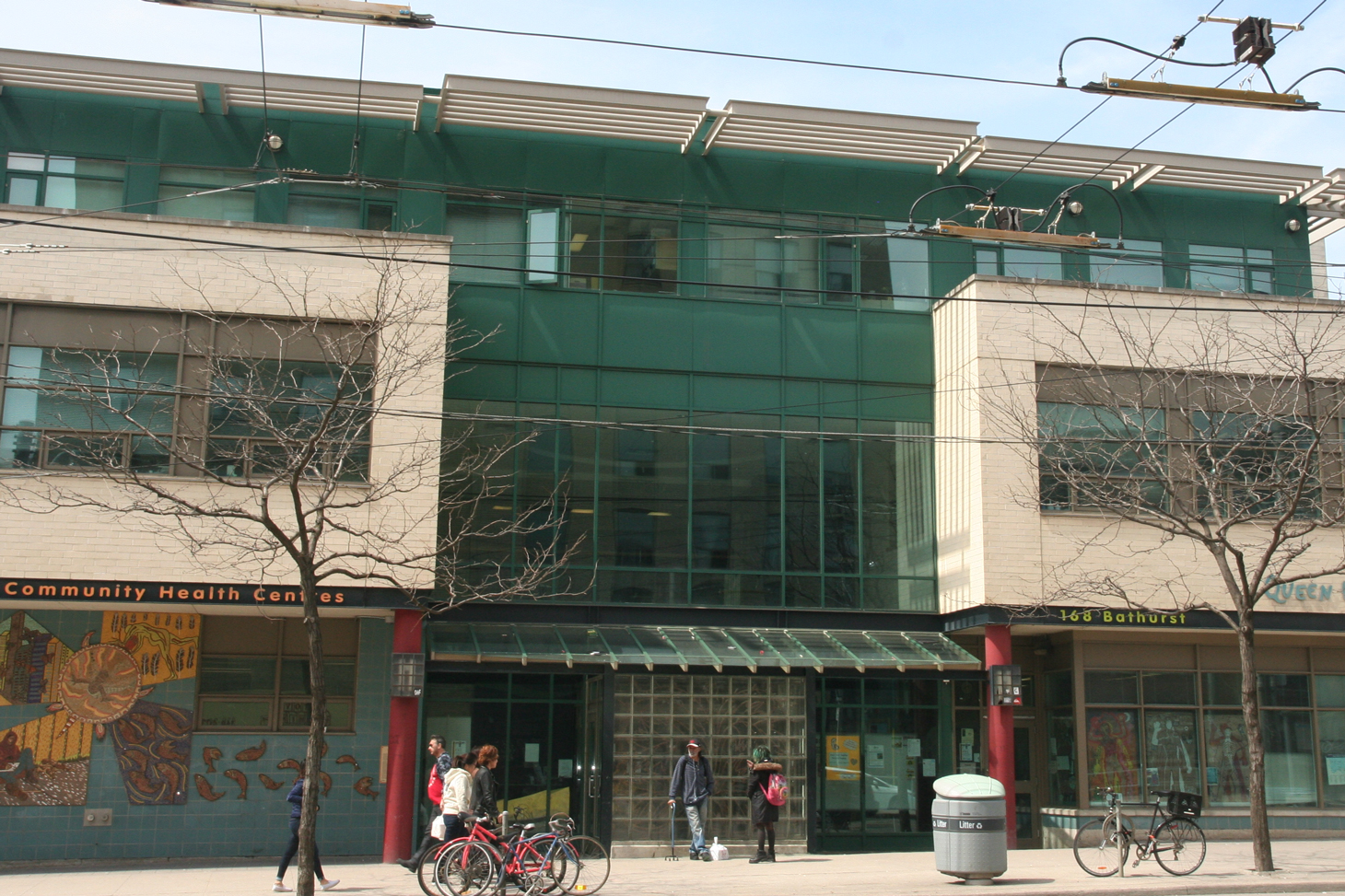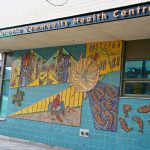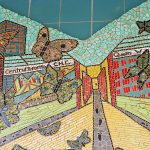
Background
The Student Health Organization of the University of Toronto (SHOUT)
In the late 1960s, a group of students in the health faculties of the University of Toronto had a vision of a storefront community centre with a health focus. The idea for the centre was conceived by students belonging to the Student Health Organization of the University of Toronto (SHOUT), which was formed in 1967. Students were “Dissatisfied with traditional health science education which keeps students in separate courses separated, the students decided to try to integrate their training” (U of T Graduate, Spring 1971).
The vision was modeled along the lines of Community Health Centres that had been developing in the United States, with the primary operational goal of using a personal and integrated approach to the physical, psychological and social problems of the area. The focus was to be on community health and educational projects, and the storefront location would be a meeting place, dispelling myths and fears about health care. Students and staff at the Centre were to provide their services as part of an inter-disciplinary care model, through communication and co-operation within allied professions.
On February 10, 1969, SHOUT began a clinic at 314 Bathurst Street, providing a host of services including comprehensive medical care, a children’s recreational program, a social program for senior citizens, tutoring for school age children, and legal aid. Medical advice was provided under the supervision of licensed physicians, who volunteered their time on a rotating basis, three nights a week. Second and third year medical students rotated through the centre on a regular schedule and patients were encouraged to see the same medical students for follow-up visits. The centre was eventually registered as a non-profit, charitable organization and became eligible for direct Ontario Health Service Insurance Claims. (See archival articles on the SHOUT clinic.)
Archival articles on SHOUT clinic (1970 & 1971)
Milestones
- In October 1969, SHOUT relocated to 64 Augusta Avenue in proximity to the Alexandra Park Community, a newly completed Ontario Housing Project of about 4,000 people, and operated from 6:30 PM to 9:30 PM, Monday to Thursday.
- In April 1970, SHOUT added a dental clinic under a licensed volunteer dentist. The clinic was subsidized by the medical program and supported by donated equipment and free drugs from pharmaceutical companies. This allowed the clinic to charge a nominal fee of $2.00 for any dental procedure, regardless of the number of visits required, and to ensure that a comprehensive service was available to all, regardless of ability to pay.
- In June 1970, the Atkinson Charitable Foundation provided a grant that allowed SHOUT to open during the day.
- In March 1971, the adjoining premises of 64 Augusta were linked to facilitate a larger and more functional community health centre and an expanded dental clinic. Morning clinics were devoted to the treatment of children from Ryerson Public School and afternoon clinics to the adult population of Alexandra Park. At this point, the students involved in the development of the centre believed they had accomplished their first objective of integrating health science education with the delivery of community health care services. Funding at this time came from a National Department of Health and Welfare grant, OHSIP generated income, and the University of Toronto’s Students’ Council.
- In 1973, a full-time physician was appointed. In addition to the medical and dental services offered, an inter-agency group, The Help Unit, was formed in Alexandra Park and housed at the Community Health Centre. The Help Unit was staffed with community volunteers and people from various other social agencies, government agencies and community groups on a rotational basis, and served as an information post and front-line contact to appropriate agencies for all types of problems. The Centre also included a free legal clinic, staffed by University of Toronto law students who worked with a local lawyer involved in legal aid activities.
- In February 1975, SHOUT was incorporated as a non-profit organization and renamed Alexandra Park Community Health Centre.
Niagara Neighbourhood Health Centre (N.N.H.C.) & West Central Community Health Centre
- In 1973, another centre – the Niagara Neighbourhood Health Centre (N.N.H.C.) – had been established in a basement on Niagara Street by a group of interested community members who wished to expand health care services to the under serviced, mixed residential and industrial areas south of Queen Street and the residential area between Bathurst, Shaw and Dundas Streets. In 1975, funding was obtained from the Ministry of Health and a clinic was opened.
- In 1977 the Ministry of Health decided that a community health centre had to have a minimum of two physicians and 4,000 patients to receive funding. In response, a West Central Community Health Centre board of directors was formed with three representatives from each clinic to consider amalgamation of the Alexandra Park and the Niagara Neighbourhood Health Centres, which became effective February 2, 1978. The West Central Community Health Centres of Toronto was incorporated without share capital (i.e. non-profit) on February 2, 1982.
- In 1981 The School of Dentistry severed its relationship with Alexandra Park Health Centre as a result of centralization of teaching facilities and problems with insurance coverage. A full-time dentist was hired in 1982.
- In 1984-85 The Niagara Neighbourhood Health Centre closed its basement location and moved to 674 Queen West.
- In the early 1990’s, Alexandra Park and Niagara Neighbourhood Health Centres amalgamated to share a common administration.
- On February 17, 1997, the West Central Community Health Centres of Toronto changed its name to become the Central Toronto Community Health Centres.
- Also in 1997, the Alexandra Park and Niagara Neighbourhood Community Health Centres moved into a new facility at 168 Bathurst Street and became the Queen West Community Health Centre, with a total catchment area encompassing that of the original CHCs. With the location identified as the Queen West site.
Information on the Queen West Building

Architect
The building was designed by architect Jerome Markson of the firm Markson Barooah Hodgson Architects Inc. and construction was completed in 1997. He is the recipient of numerous awards of recognition for his work and is a fellow of the Royal Architectural Institute of Canada, as well as the Toronto Society of Architects, where he has served as president. He is also a member of the Royal Canadian Academy of the Arts. Jerome states, “After graduating from the School of Architecture at the University of Toronto a decade after the Second World War, I became committed to developing architecture that had a positive social impact”. This is reflected in the body of his work which includes, Alexandra Park Housing, Woodgreen Community Housing, numerous co-op housing, Ronald McDonald House, Bathurst Library and Toronto Botanical Garden, just to name a few of his projects.
Visit Jerome Markson’s website to learn more about him and his work.
Architect’s Statement about the Building, 1996
The building at 168 Bathurst forms the consolidation of the Alexandra Park and Niagara Neighbourhood Community Centres in this generally needy and low income area. A multi-disciplinary Centre, it was designed to provide integrated medical, dental, community health and social services as well as neighbourhood meetings of a general nature.
We designed the building to look bright and cheerful in this run-down neighbourhood and to appear accessible and inviting to people, some of whom had never been in a health centre.
Clinical areas must all be adjacent to each other, and for this reason are placed on the second level, with the first floor being used for outreach and social services and public health lessons, and nutritional teaching. Folding partitions enable a space to be created for large public meetings of all kinds. We have infant care rooms available while the parent attends in other parts of the building. The third level is for staff with a large area available for rental to associated groups.
The building has been carefully designed from all aspects of environmental concern, and features the openable windows demanded by staff, all of whom were on the building committee. Hard wearing graffiti-proof materials were used both within and without.
We feel we have created a handsome addition to the neighbourhood, which helps to upgrade the area in an urbanistic desirable manner that revives this part of town, but also seems to fit naturally with its neighbours.
Within it is open, welcoming, non-intimidating and easily accessible. The client inspired a neighbourhood competition amongst local artists – three were chosen and produced admirable works related to the healing process.
Project Manager Statement about the building — Richard Seligman
In 1993, the Board of the Central Toronto Community Health Centre (formerly West Central Community Health Centres) decided that it needed to consolidate its two facilities (one in a storefront on Queen St. West, and the other in converted pair of semi-detached houses on Augusta Avenue in Alexandra Park) into a new, purpose-built building in order to achieve its objectives as an essential provider of health care and related services to the local area community.
From that point in time, a number of activities were set in motion to achieve the construction of the new building – the beginning of the process to secure funding from the Ministry of Health, the search for and purchase of a new site (the current location of the CTCHC), the beginning of approvals from the City, and the start of the process of the planning and design.
Over the course of the next year or so, the design of the building was prepared, revised, and re-revised through a very comprehensive and thorough consultation process with the Board, staff, clients, community members and partners to ensure that the building reflected their values and objectives.
In January 1995, the design team, including Jerome Markson, Architects, R. Seligman Associates Planner and Project Manager, the Executive Director Walter Weary, staff, and others working hard on the completion of the design of the building, introduced the idea of making art an important part of the new project. It was understood at the time that while the Ministry of Health would fund the construction of the building, it would not fund the acquisition of art for the building. In spite of that, the Board approved the formation of an art selection committee with community member involvement and announced that $100,000 would be budgeted for art work.
The construction of the building began with a ground breaking ceremony in May, 1996. During the course of the construction, the art selection committee selected, through competitions, and through commissioning, the artists that would produce works uniquely designed for the building, and art works which would be incorporated into the new building.
It is to the credit of the architect, Jerome Markson, to have initiated the idea of art as an essential part of the new building, to the Board to have supported the idea, to the selection committee that successfully managed the process of selecting the artists and the art works.
The art on display and built into the building (the large mural in the reception area on the second floor, for example) is work of high quality and beauty still to be admired. The works contribute handsomely to the building as expressions of the higher values of the CHC and its mission – to improve the health and quality of life of the communities it serves.
Building to heal a community — The Toronto Star article by Architect columnist Christopher Hume
The building was featured in a September 1997 review by the Toronto Star columnist Christopher Hume. In the article Hume remarked, “Markson’s quiet mastery makes him one of the rare architects who creates cities while designing buildings. Too often the truth is exactly opposite.”
To read the complete article click on the link document below:
Art at Queen West
As you walk through the health centre, we invite you to pause and view three commissioned works of art that were created for Queen West by three local artists.
A steel and glass mosaic tile structure “Simpler’s Joy” by John McKinnon that depicts “the herb Vervain which has been used since medieval times as a general cure all. Herbs were called simples and herbalists were called simplers, hence the term Simpler’s Joy” for the title of the piece. Look for it just inside the front door.

Triptych paintings by Brian Kipping portray the Alexandra Park and Niagara Neighbourhood sites and the gas station that once existed at the current Queen West site. It is on the wall by the ground floor reception desk.

A mural “The Great Mystery – Walk In Balance” by Rebecca Baird (Cree/Metis) that “speaks to the full breadth of experience within a health care facility… I chose the raven image because throughout times the Raven has carried the medicine of magic. I’ve included the four medicines given to Native peoples, Sage, Sweet grass, Cedar and Tobacco. The traditional healing practices involve the whole person, the healing of the body mind and spirit, hence the image of the eagle feather.”


The artworks were chosen by an Art Committee that included clients, local artists, staff and board members, and Jerome Markson, the architect of the building. Artists who live in the Queen West area were invited to make submissions.
We received 45 submissions and 6 were awarded project development grants and asked to prepare a model, drawings and a project proposal. The final selections were based on these submissions.
On the evening of April 24, 1998, the official unveiling of the art was celebrated by members of the art community and friends of Queen West.
Queen West has continued the integration of art in the Centre as part of the community building work and recognition of art as a healing medium. The Community Mosaic Project in 2012 led by artist Anna Camilleri is part of that continuing tradition.





